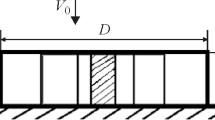Abstract
For the purpose of delineating the applicability of simple uniaxial wave-propagation theory to a class of axisymmetric structures, an experimental and a two-dimensional numerical investigation involving the transmission of longitudinal waves produced by impact of steel spheres was conducted. The axisymmetric samples were fabricated by cementing together two components of equal length; the constituents were either uniform circular bars or tubes of aluminum or steel of different diameters that produced a target either with an abrupt discontinuity or a continuous lateral surface at the center. The principal tests involved pulse durations of about 50 μs corresponding to a minimum pulse length-to-bar diameter ratio of 6.7 where the transmitted and reflected stress ratios obtained from surface strain-gage measurement were generally found to be predicted by elementary bar theory within experimental error no larger than ±3 percent. Much poorer correlation in these values was obtained for tests involving pulses of substantially shorter duration; here, the dispersive effects capable of being predicted only by higher-order theories were prominently manifested. A two-dimensional analysis for a few configurations was executed using a finite-element procedure and compared with the predictions from elementary theory and with test results; for the 30-μs pulse duration employed, this calculation provided no improvement relative to elementary theory for the predictions of strain histories at stations even only slightly removed from the discontinuity. Both measurement and the results of the two-dimensional calculations indicated that stress uniformity across the section was achieved at stations as close as two bar diameters from the discontinuity for pulse durations ranging from 25 to 50 μs.
Similar content being viewed by others
References
Ripperger, E.A. and Abramson, H.N., “Reflection and Transmission of Elastic Pulses in a Bar at a Discontinuity,” Proc. of the 3rd Midwestern Conf. on Solid Mech., 135–145 (1957).
Plunkett, R. andDoolen, R.B., “Reflection and Transmission Coefficients for Stress Waves in Bars,”J. Acoust. Soc. Am.,35,1457–1458 (1963).
Habberstad, J.L. andHoge, K.G., “Effects of a Discontinuity in a Cross Section on an Elastic Pulse,”J. Appl. Mech.,38,280–282 (1971).
Habberstad, J.L., “Axisymmetric Elastic Wave Propagation in Bars Containing a Discontinuity.” PhD Dissertation, Washington State University (1969).
Kenner, V.H. andGoldsmith, W., “Elastic Waves in Truncated Cones,”Experimental Mechanics,8 (10),442–449 (1968).
Mortimer, R.W., Schaller, R.J., andRose, J.L., “Transient Axisymmetric Motions of a Conical Bar,”J. Appl. Mech.,39,709–716 (1972).
Boucher, S. andKolsky, H., “Reflection of Pulses at the Interface between an Elastic Rod and an Elastic Half-Space,”J. Acoust. Soc. Am.,52,884–898 (1972).
Mortimer, R.W., Rose, J.L. andBlum, A., “Longitudinal Impact of Cylindrical Shells with Discontinuous Cross-Sectional Area,”J. Appl. Mech.,39,1005–1010 (1972).
Rose, J.L., Blum, A. andMortimer, R.W., “Effects of Discontinuities in Cylindrical Tubes on a Transmitted Pulse,”AIAA Jl.,13,227–229 (1975).
Kenner, V.H., Goldsmith, W. andSackman, J.L., “Longitudinal Impact on a Hollow Cone,”J. Appl. Mech.,36,445–450 (1969).
Cohen, H. andBerkal, A.B., “Wave Propagation in Conical Shells,”J. Appl. Mech.,39,1166–1168 (1972).
Fisher, H.D., “Wave Propagation in a Hollow Conical Frustum,”J. Appl. Mech.,39,1159–1161 (1972).
Valathur, M., “Wave Propagation in a Truncated Conical Shell,”Int. J. Solids Structures,8,1223–1233 (1972).
Davies, R.M., “A Critical Study of the Hopkinson Pressure Bar,”Phil. Trans. Roy. Soc. Lond., Ser. A.,240,375–457 (1948).
Calder, C.A. and Goudreau, G.L., Application of the Finite-Element Technique to Stress Wave Propagation, Preprint UCRL 79298, Lawrence Livermore Laboratory (1977).
Hughes, T.J.R., et al., “A Finite Element Method for a Class of Contact-Impact Problems,”Computer Meth. Appl. Mech. Eng.,8,249–276 (1976).
Oi, K., “Transient Response of Bonded Strain Gages,”Experimental Mechanics,6 (9),463–469 (1966).
Barez, F., Goldsmith, W. andSackman, J.L., “Longitudinal Waves in Liquid-Filled Tubes: II. Experiments,”Int. J. Mech. Sci.,21,223–236 (1979).
Goldsmith, W., Lee, P. andSackman, J.L., “Pulse Propagation in Straight Circular Elastic Tubes,”J. Appl. Mech.,39,1011–1018 (1972).
Sackman, J.L. andGoldsmith, W., “Longitudinal Impact on a Circular Cylindrical Tube,”Int. J. Solids Structures,8,261–267 (1972).
Author information
Authors and Affiliations
Rights and permissions
About this article
Cite this article
Barez, F., Goldsmith, W. & Sackman, J.L. Longitudinal wave propagation in axisymmetric structures with material and/or aereal discontinuity. Experimental Mechanics 20, 325–333 (1980). https://doi.org/10.1007/BF02321119
Received:
Accepted:
Issue Date:
DOI: https://doi.org/10.1007/BF02321119



